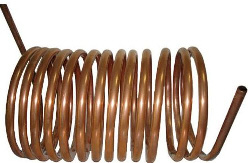Copper Calculations
Apr
27
2017
I’m planning on making some heat exchangers. It sounds fancy, but all I’m doing is coiling some soft copper pipe.
My goal is the most bang for my buck, so what’s the best way of arrangement of copper for dollars.
Here’s an example:

My constraint: the water inlet and outlet are 3/4″ copper pipe.
For this analysis, I’m standardizing on a length of 50′ of coil.
The first obvious choice is using 3/4″ diameter to match the existing piping. A 50′ roll of soft copper pipe runs about $80 for 3/4″ diameter.
The main factor in heat transfer is surface area, so for a cylinder we need pi*d*h. The diameter is 3/4″ -> circumference of 2.356. For one foot, that’s 28.274 sq.in. of pipe. At $1.60 per foot, that’s 5.66 cents/sq.in.foot.
For cheaper, I could go with 1/2″ soft pipe. That would result in a faster flow though, which would give less time for heat to transfer, so I don’t know that it is a good choice. But we’ll look at it anyway.
The diameter is 1/2″ -> circumference of 1.571. For one foot, that’s 18.852 sq.in. of pipe. At $1.00 per foot, that’s 5.30 cents/sq.in.foot, a slightly better deal.
So the thinner pipe is slightly cheaper on a surface area basis. But the overall surface area is less and the water will flow faster so it won’t transfer heat as well, so that works counter to the point of a heat exchanger.
To get the same performance, we need the same cross section. Area of 3/4″ = 0.4418. Area of 1/2″ = 0.1963, or approximately half of the area of the 3/4″ diamter pipe. So if I double up the 1/2″ pipe, I can get the same flow as the 3/4″ pipe.
But what about surface area? That doubles! So slightly smaller cross section total, but (18.852 + 18.852)/28.274 = 33% more surface area. Looks like it is better heat transfer performance to have two 1/2″ pipes rather than one 3/4″ pipe.
Now let’s check the other part of the equation: cost.
The two 50′ pipes will cost double a single pipe (no, a 100′ pipe costs more than double, so I wouldn’t save anything by buying that and cutting it in half).
So 33% more performance for (100/80) = 25% more cost. Sounds like a good deal.
One more adjustment, just to make sure all the bases are covered: the area.
The 3/4″ pipe has (0.4418/(0.1963+0.1963)) = 12.5% more cross-sectional area. Which in theory would mean the water flows slower and has more time to absorb the heat.
So 33% more surface area but with a 12.5% reduction for flow rate, compared to 25% more cost for these two choices.
In conclusion, I’m going with the single 3/4″ pipe because it’s half the number of joints to solder therefore the double 1/2″ pipes are twice as likely to fail.
Iron is taken from the dust, And copper is smelted from rock.
Job 28:2




This little article thingy was written by Some Guy sometime around 6:05 am and has been carefully placed in the Projects category.

 This is Alpha, the first-born, when he was 2YO.
This is Alpha, the first-born, when he was 2YO. This is Beta, the second-born, when he was about 2YO.
This is Beta, the second-born, when he was about 2YO. This is Gamma, the third-born, when he was about 18MO.
This is Gamma, the third-born, when he was about 18MO.

